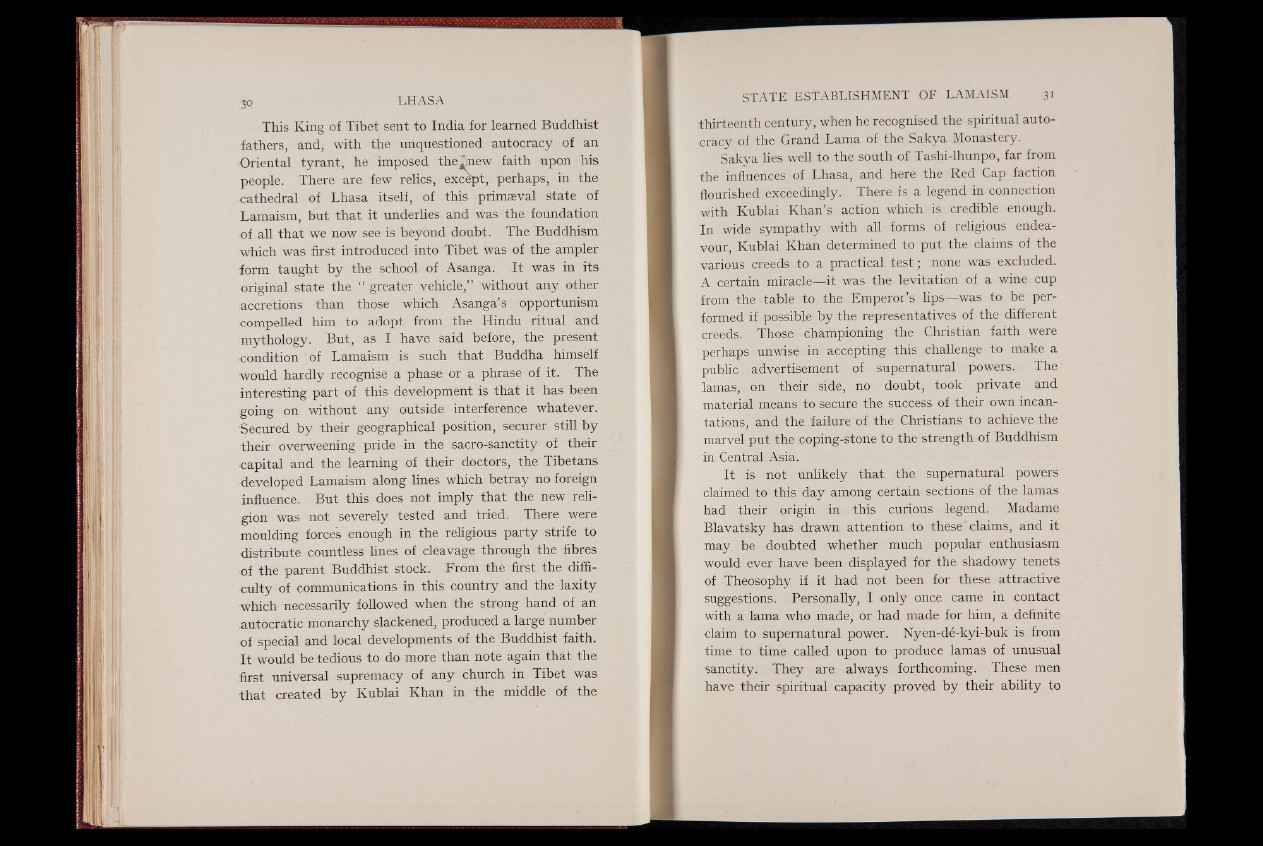
This King of Tibet sent to India for learned Buddhist
fathers, and, with the unquestioned autocracy of an
Oriental tyrant, he imposed the Anew faith upon his
people. There are few relics, except, perhaps, in the
cathedral of Lhasa itself, of this primaeval state of
Lamaism, but that it underlies and was the foundation
of all that we now see is beyond doubt. The Buddhism
which was first introduced into Tibet was of the ampler
form taught by the school of Asanga. It was in its
original state the “ greater vehicle,” without any other
accretions than those which Asanga’s opportunism
•compelled him to adopt from the Hindu ritual and
mythology. But, as I have said before, the present
■condition of Lamaism is such that Buddha himself
would hardly recognise a phase or a phrase of it. The
interesting part of this development is that it has been
going on without any outside interference whatever.
Secured by their geographical position, securer still by
their overweening pride in the sacro-sanctity of their
capital and the learning of their doctors, the Tibetans
developed Lamaism along lines which betray no foreign
influence. But this does not imply that the new religion
was not severely tested and tried. There were
moulding forces enough in the religious party strife to
distribute countless lines of cleavage through the fibres
of the parent Buddhist stock. From the first the difficu
lty of communications in this country and the laxity
-which necessarily followed when thé strong hand of an
autocratic monarchy slackened, produced a large number
of special and local developments of the Buddhist faith.
I t would be tedious to do more than note again that the
first universal supremacy of any church in Tibet was
that created by Kublai Khan in the middle of the
thirteenth century, when he recognised the spiritual autocracy
of the Grand Lama of the Sakya Monastery.
Sakya lies well to the south of Tashi-lhunpo, far from
the influences of Lhasa, and here the Red Cap faction
flourished exceedingly. There is a legend in connection
with Kublai Khan’s action which is credible enough.
In wide sympathy with all forms of religious endeavour,
Kublai Khan determined to put the claims of the
various creeds to a practical test; none was excluded.
A certain miracle— it was the levitation of a wine cup
from the table to the Emperor’s lips— was to be performed
if possible by the representatives of the different
creeds. Those championing the Christian faith were
perhaps unwise in accepting this challenge to make a
public advertisement of supernatural powers. The
lamas, on their side, no doubt, took private and
material means to secure the success of their own incantations,
and the failure of the Christians to achieve the
marvel put the coping-stone to the strength of Buddhism
in Central Asia.
It is not unlikely that the supernatural powers
claimed to this day among certain sections of the lamas
had their origin in this curious legend. Madame
Blavatsky has drawn attention to these r claims, and it
may be doubted whether much popular enthusiasm
would ever have been displayed for the shadowy tenets
of Theosophy if it had not been for these attractive
suggestions. Personally, I only once came in contact
with a lama who made, or had made for him, a definite
claim to supernatural power. Nyen-de-kyi-buk is from
time to time called upon to produce lamas of unusual
sanctity. They are always forthcoming. These men
have their spiritual capacity proved by their ability to